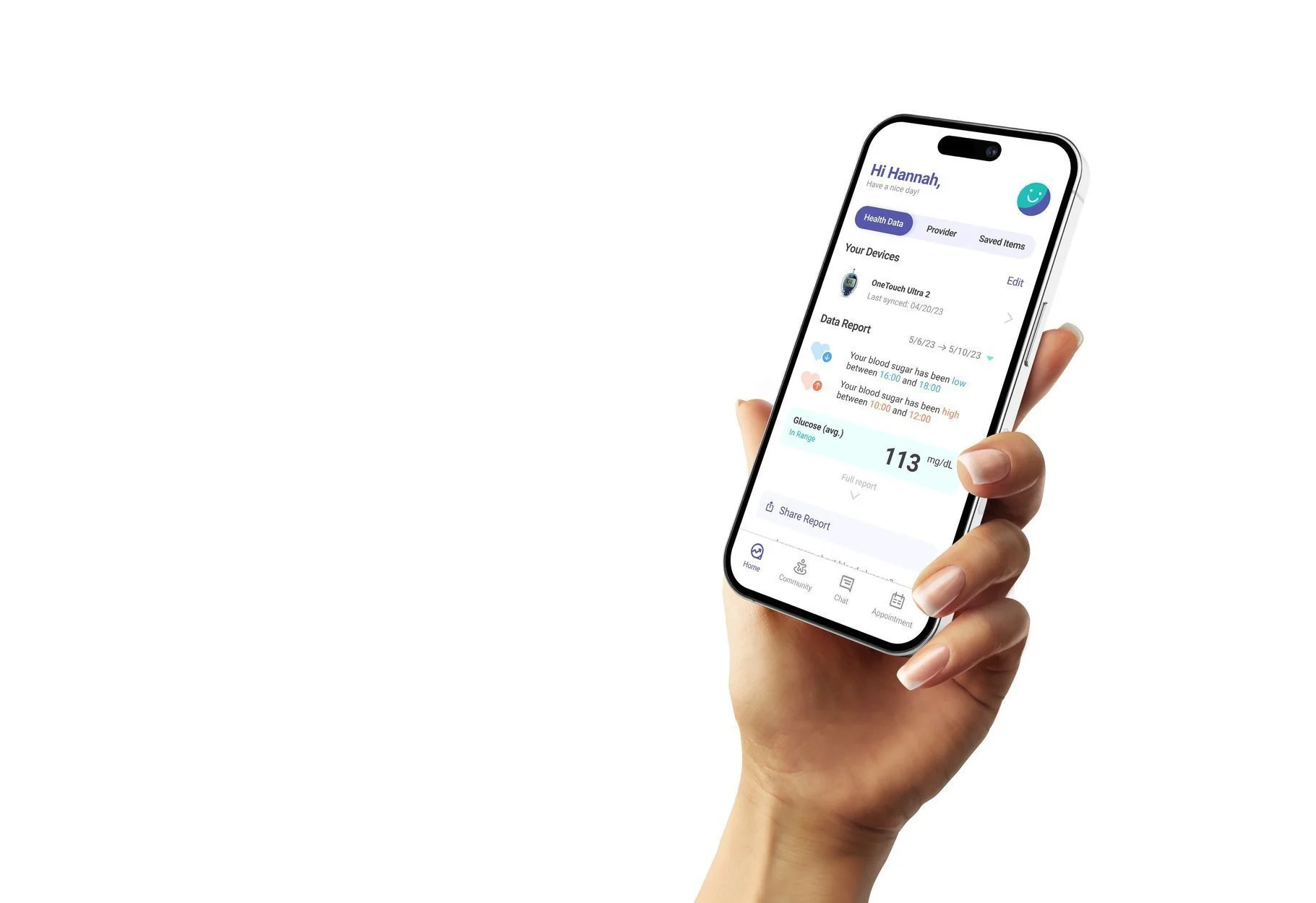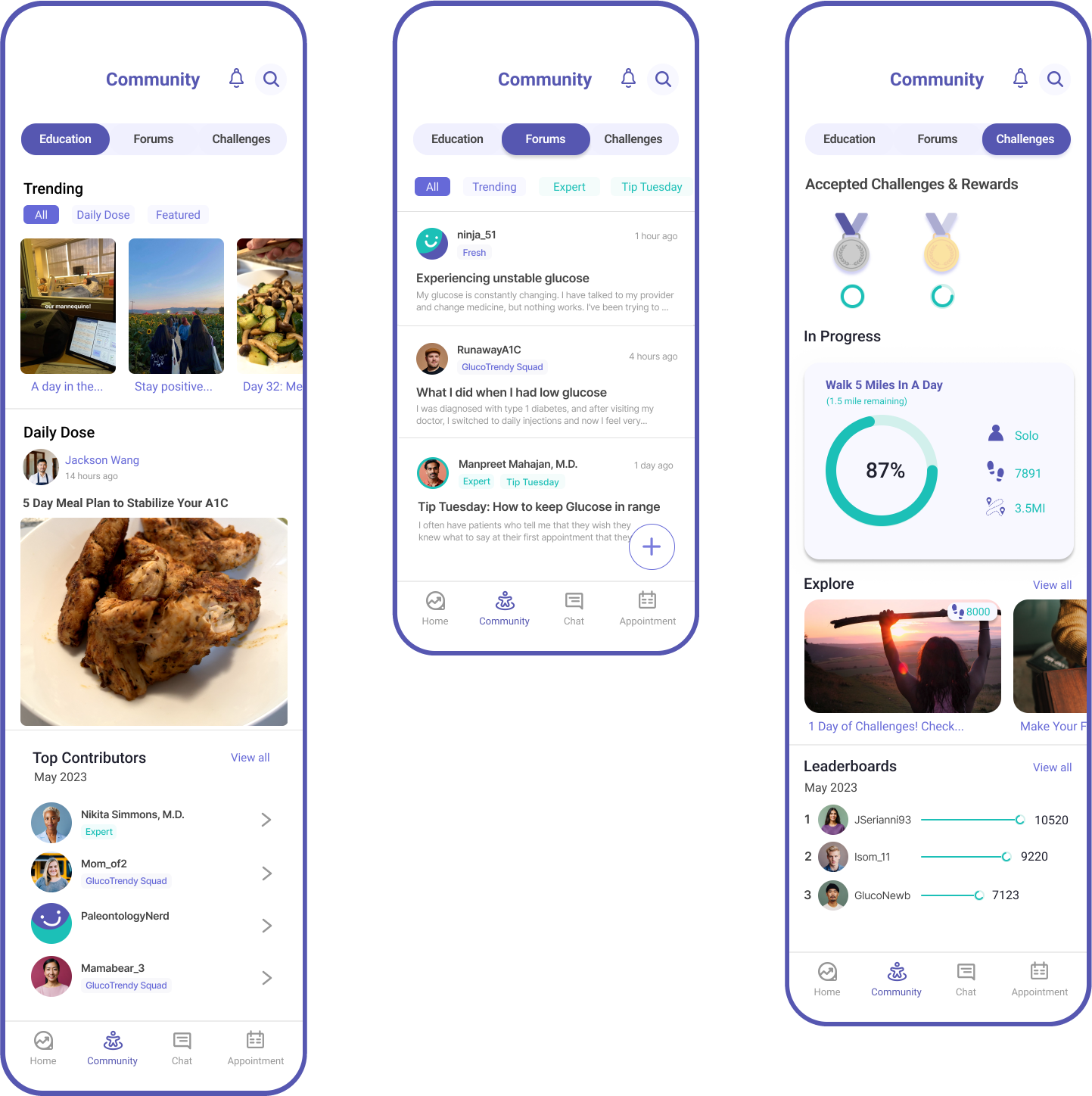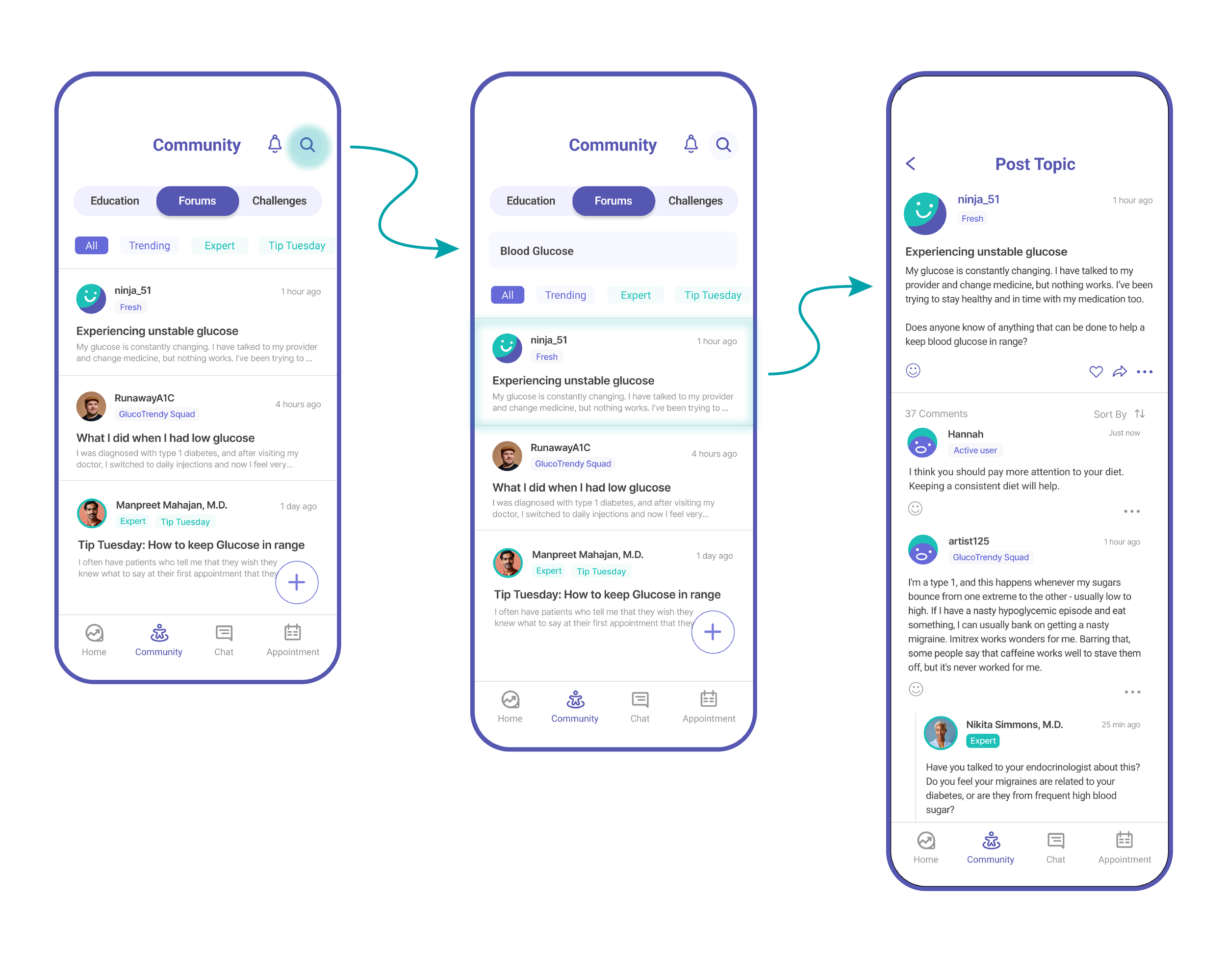GlucoTrend
The world’s first all-in-one self-care management app for Type 1 Diabetes
Project Details
I worked on a team of six students, under two mentors from MayoClinic.
We were tasked with creating a solution to assist patients with the chronic condition Type 1 Diabetes Mellitus create and adhere to a self-care management plan.
So, we created an app that features:
A unified platform for vital self-care information & education such as patient blood glucose history, provider handouts, articles, upcoming appointments, etc.
An official, moderated community specific to type 1 diabetes patients and medical professionals to provide social and emotional support.
Motivating challenges that transform the stress of major lifestyle changes into a positive, rewarding, fun experience.
My Tasks
Community Pages: Managed the overall design and consistency of the community, forums, and challenges screens
Research: Coordinated interviews, interviewed stakeholders, collected & synthesized data into themes and insights that drove major feature decisions
Foundations: Wireframed, created custom icons & assets, managed team meeting structures, and prototyped the community, forums, and challenges page interactions in Figma
Tools
Figma
Adobe: Photoshop, Illustrator
Google Drive
Miro
Canva
Zoom
Timeline
10 Weeks
Spring 2023
Type
Academic Project
San Jose State University

Research and Insights
Research
Conducted Interviews
Individually I was able to conduct three interviews, two on type 1 patients and one type 2 patient.
To gain deeper insight, I used tactics such as open ended questions and asked them to draw pictures.
In total I read ten peer-reviewed medical journals about type 1 diabetes and tactics of self-care management.
I especially looked at articles from MayoClinic’s website to understand the platform better.
Target Users
Type 1 Diabetes
Younger Adults (18 - 30)
Newly Diagnosed
&
Providers
We realized that it would be vital to design for the user experience of both the patient and their health care providers.
Pain Points
In my research, I found that newly diagnosed T1DM patients struggle most with:
Emotional health management after diagnosis, because there is no known cure
Finding a community of other Type 1 patients to interact with
Committing to a completely new lifestyle that is time consuming but necessary to live
Read Peer-Reviewed Journals & Articles
Watched “Day In The Life" Vlogs
This is what our team’s shared Drive folder for our foundational research looked like. The above list was not exhaustive by any means- we of course had to constantly update our research throughout the project as it rapidly evolved!
At first we had a much broader focus that covered both type 1 and type 2 diabetes, for people of any age, and did not consider length of diagnosis. We ran into quite a few issues with scale due to the relatively limited scope of the project timeline, and as such we decided to narrow our target audience. Through our research we identified younger adults who are newly diagnosed with type 1 had the most needs.
Empathy maps we filled out based on real interviews we conducted (fake names and pictures).
These are the summarized personas from a type 1 patient (purple), and a type 2 patient (blue). We decided to interview both types regardless of our scope in order to better understand diabetes as a whole.
Current and future state storyboards I created to better understand how GlucoTrend could help our type 1 users.
I was drawn to take on the community feature because of how often the mental health issue came up while reviewing medical journals, my interview notes, and day in the life vlogs. It became apparent that a lack of social support and connection were major road blocks for the patients motivation to comply with creating and maintaining a self-care management plan.
Slow communication
Appointment logistics
A lot of communication sources to monitor
Obtaining and reading data quickly
Non-compliant patients
HIPAA considerations
Existing software systems in healthcare considerations
Providers
“I am a medical provider that is trying to help a new type 1 diabetes patient with their self-care plan, but my current systems take up a lot of time, which makes me feel frustrated.”
Patients
“I am an adult newly diagnosed with type 1 diabetes and I want to manage my condition, but I don’t know where to begin with all the new information and tasks, which makes me overwhelmed.”
Slow communication
Appointment logistics
Confusing and unreliable info online
Keeping track of data in one place
Difficulty predicting glucose highs and lows
Difficulty staying motivated
Feelings of isolation and loneliness
To better understand and empathize with the actual daily struggles of patients, I watched videos from two type 1 vloggers.
Recorded lectures from doctors and professors were also a valuable source of information.
Laying the foundations
Site Map
Wireframes
Our team went through several rounds of wireframe concepts and testing:
We started with three distinct layouts
Narrowed down to one style
Modified that one to be consistent
Initially education was separate from community, and I had to work with the group member in charge of that feature to decide how to integrate it (more about that later).
Feature: Community
The Community page has three main functions: education, forums, and challenges.
The landing page is the education tab.
Originally education was completely separate from community. As we developed and tested the app screens, it became apparent that there was overlap between the function of these two features.
I worked with my teammate to merge our original landing pages into one. They worked on the trending and daily dose content, and I worked on the top contributors section for that page.
Feature: Forums
The forums were created as one of the core ways to encourage patients to connect with each other in order to receive social support.
Search, scroll, or browse by tags
Expert led topics are colored green for quick identification.
Within each topic, users can comment, rate comments, and save & share threads.
If a topic or comment has an issue, users can report and/or hide the topic or comment under the “…” icon.
Feature: Challenges
Evidence shows that adherence to a self-care management plan increases significantly when motivators such as personalized goals and challenges are made available to patients.
View earned awards
At a glance dashboard to view in progress challenges
Browse new challenges to take on
See the monthly leader boards to increase motivation
I contributed to the react and helpful icons. All others are free to use from FlatIcon and Figma.
I created the default profile picture illustrations as well. They were inspired by the rounded part of the blood drop in our logo.
Takeaways
what I learned during this project
new skills acquired
in the future hope to continue working on: the provider side, esp in forums, challenges integration with fitness trackers, and community interactions w challenges (teams?)
Special thank you to MayoClinic for supporting this case study.
Icons courtesy of Freepik from FlatIcon.com




















